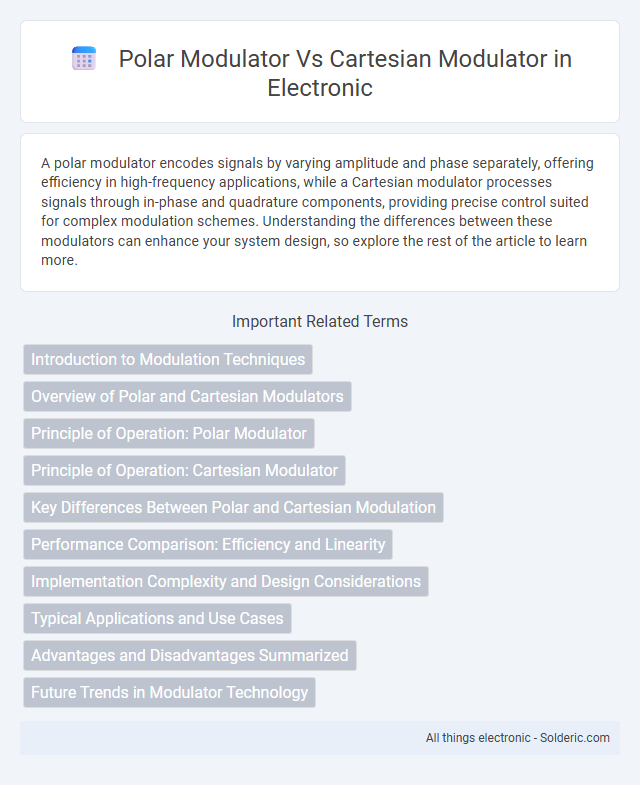A polar modulator encodes signals by varying amplitude and phase separately, offering efficiency in high-frequency applications, while a Cartesian modulator processes signals through in-phase and quadrature components, providing precise control suited for complex modulation schemes. Understanding the differences between these modulators can enhance your system design, so explore the rest of the article to learn more.
Comparison Table
| Feature | Polar Modulator | Cartesian Modulator |
|---|---|---|
| Signal Representation | Amplitude and phase separately | In-phase (I) and quadrature (Q) components |
| Complexity | Lower at RF; complex baseband processing | Complex RF circuitry |
| Linearity | Improved linearity over power amplifier | Dependent on linearity of RF components |
| Efficiency | High efficiency due to amplitude and phase separation | Moderate efficiency; requires linear amplifiers |
| Bandwidth | Better suited for wideband signals | More sensitive to bandwidth limitations |
| Applications | High-power transmitters, RF front-ends | Modems, software-defined radios |
| Distortion Handling | Compensates AM-PM distortion effectively | Prone to distortion if I/Q imbalance occurs |
Introduction to Modulation Techniques
Polar modulators encode signals using separate amplitude and phase components, improving efficiency in power amplification for RF transmitters. Cartesian modulators represent signals through orthogonal in-phase (I) and quadrature (Q) components, enabling precise signal manipulation and reduced distortion. Understanding the differences between these modulation techniques can enhance your ability to design optimized communication systems.
Overview of Polar and Cartesian Modulators
Polar modulators separate signal amplitude and phase into magnitude and angle components, enabling efficient power amplifier operation with reduced signal distortion in phase-modulated signals. Cartesian modulators process in-phase (I) and quadrature (Q) components directly, simplifying digital signal processing and providing precise control over vector signal modulation. Both techniques serve critical roles in modern communication systems, with polar modulators favored in high-efficiency RF power amplifiers and Cartesian modulators preferred for linear modulation schemes requiring high accuracy.
Principle of Operation: Polar Modulator
A Polar modulator operates by separately processing the amplitude and phase components of a signal, converting the amplitude information into a pulse-width modulated signal and the phase information into a phase-modulated carrier. This technique efficiently manages power amplifiers by enabling the use of non-linear amplifiers with constant envelope signals, enhancing efficiency in RF transmission. Your system benefits from reduced signal distortion and improved power efficiency compared to Cartesian modulators that process in-phase (I) and quadrature (Q) signals directly.
Principle of Operation: Cartesian Modulator
Cartesian modulators operate by independently modulating the in-phase (I) and quadrature (Q) components of a signal, enabling precise amplitude and phase control through digital or analog means. These modulators generate two orthogonal signals that are combined to produce the desired complex modulation format, such as QAM or QPSK. The principle allows for straightforward signal processing and linear amplification, making Cartesian modulation ideal for high-linearity applications in RF communication systems.
Key Differences Between Polar and Cartesian Modulation
Polar modulators separate amplitude and phase signals, enabling efficient power amplifier operation by converting these signals into polar coordinates before transmission. Cartesian modulators process in-phase (I) and quadrature (Q) components directly, simplifying signal generation but often increasing complexity in linearization and power efficiency. The key difference lies in signal representation; polar modulation enhances efficiency and linearity in RF amplifiers, whereas Cartesian modulation offers precise control at the cost of power amplifier demands.
Performance Comparison: Efficiency and Linearity
Polar modulators offer higher efficiency in power amplification by separating amplitude and phase signals, reducing power dissipation, while Cartesian modulators maintain better linearity by processing in-phase and quadrature components directly. Efficiency gains in polar modulation come at the expense of increased complexity in handling amplitude modulation distortion, whereas Cartesian modulation's inherent linear processing ensures superior signal fidelity but with typically lower power efficiency. Your choice depends on whether power efficiency or signal linearity is the priority in your communication system design.
Implementation Complexity and Design Considerations
Polar modulators simplify power amplifier design by separating amplitude and phase components, reducing implementation complexity in RF front-ends. Cartesian modulators require precise IQ imbalance and offset calibrations, increasing design intricacies and demanding advanced signal processing algorithms. Choosing the right modulator depends on your system's tolerance for hardware complexity and the desired linearity performance.
Typical Applications and Use Cases
Polar modulators are widely used in RF power amplifiers for wireless communication systems, including satellite transmitters and cellular base stations, where efficiency and linearity are crucial. Cartesian modulators, favored in software-defined radios and complex modulation schemes like QAM and OFDM, provide precise amplitude and phase control needed in broadband communication and radar systems. Your choice depends on the application's emphasis on power efficiency (polar) versus signal accuracy and flexibility (Cartesian).
Advantages and Disadvantages Summarized
Polar modulators offer advantages such as improved power efficiency and reduced signal distortion by independently modulating amplitude and phase, making them ideal for high-frequency RF applications. However, they face challenges including complex circuitry and potential synchronization issues between amplitude and phase paths. Cartesian modulators provide simpler implementation and better linearity control but often suffer from inefficient power usage and increased signal distortion due to intertwined amplitude and phase modulation.
Future Trends in Modulator Technology
Future trends in modulator technology emphasize the integration of advanced digital signal processing to enhance the efficiency and linearity of both Polar and Cartesian modulators. Polar modulators are expected to benefit from improvements in amplitude and phase control accuracy, enabling higher power efficiency for 5G and beyond wireless communication systems. Cartesian modulators continue to evolve with adaptive predistortion techniques and AI-driven optimization, supporting increasingly complex modulation schemes for next-generation connectivity solutions.
Polar modulator vs Cartesian modulator Infographic

 solderic.com
solderic.com